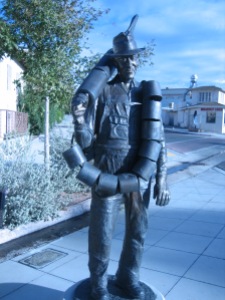[amazon template=image&asin=080417153X]I first heard of the novel The Water Knife (set in the American Southwest, primarily in Phoenix, AZ) from a blurb in Sunset magazine (http://www.sunset.com/). The description intrigued me, and I wanted to read the book. Thanks to a kind BookMooch (http://bookmooch.com/) member, I had my chance.
In author Paolo Bacigalupi’s Phoenix, water is precious and scarce, and society is divided according to who has it and who doesn’t. The rich have water, of course, The rich live in lavish “arcologies” where all waste water is sceientifically filtered clean and reused. The rich have plenty of water to drink, can bathe whenever they want, have their clothes cleaned regularly, and even use flush toilets. The poor have limited water resources. The poor live in squats built from salvaged materials or abandoned houses; neither type of housing has running water. The poor buy their water one gallon at a time from pumps with fluctuating prices. The poor are dusty dirty because they can rarely shower or wash their clothes. Needless to say, there are no flush toilets for the Phoenix poor.
Not every place in this distopia Southwest has the water problems Phoenix does. Things are much worse in Texas, and refugees have poured into Arizona via New Mexico. The good people of New Mexico wanted nothing to do with Texas regugees and sent them on their way, sometimes violently. Life isn’t so hard in California and Nevada, and those states want to keep it that way by limiting who crosses their borders to use their limited resources. In this world, coyotes still guide people across borders, but the borders crossed are into states with water.
The most important thing in this world are water rights, and the water knife of the title makes sure his boss gets the water rights she needs to stay wealthy and priviliged.
There’s a lot of dark action in this book: shooting, torture, murder, death. Young women (called “bangbang girls,” usually Texans) sell their bodies for money and, hopefully, the chance to wash their panties in the sink while the rich man sleeps. A man who controls a neighborhood and demands a percentage of the money the area residents earn uses hyenas as part of his enforcement plan. Dams are blown up and precious water is diverted. People are tortured for answers. This book is so dark, in fact, that I put it aside for four months after reading the first nine chapters. The book was good, but it had me on edge, knowing all the characters were facing terrible fates. When I picked it up the second time, I must have been in a better state of mind, because I was able to enjoy the story without letting the violence get to me.
The action of the novel just keeps coming. I enjoyed the suspense of not knowing what would happen next or who would doublecross whom. I did, however, figure out the story’s key mystery long before the characters did. (Of course, I had a big picture view the characters were lacking.)
I also enjoyed the characters. I was pleased to see two of the three main characters through whose eyes the story is told are women. The women aren’t damsels-in-distress women either, but strong, ass-kicking, gonna do what has to be done women. Even though the book is primarily an action/adventure/mystery story, there is also character development, which I appreciated.
The social problems the book examines are not easy to look at. What happenes when modern life as we know it breaks down? What happens when one of humankind’s most basic, most necessary resources becomes so scare people are willing to kill for it? What happens when the environment changes to the point people may no longer be able to survive on the surface of the earth? The Water Knife raises these questions and offers only bleak answers.
Still, I’m glad I read this novel. It was difficult to get through some parts of it, but those hard parts really made the story ring true. It’s a good book, but maybe not for readers who can’t handle the dark side of humanity.





